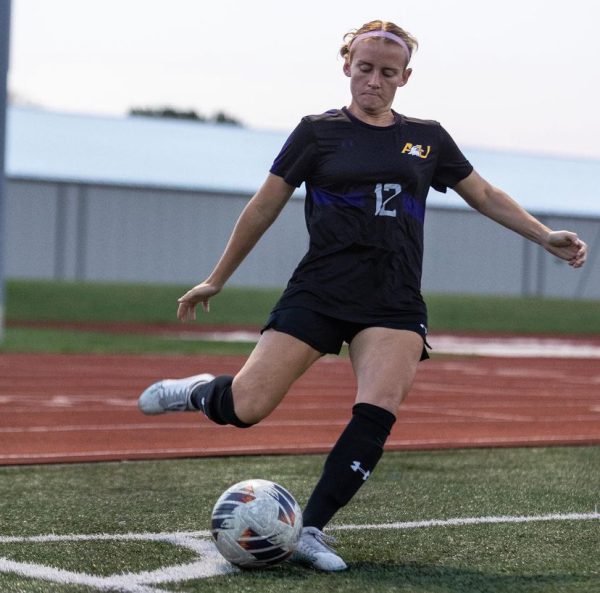Why not us? Season cut short
November 17, 2016
On Saturday the Ashland University Eagles football team wrapped up their 2016 regular season as they clinched their second straight Great Lakes Intercollegiate Athletic Conference South title.
Many are wondering how a 9-2 team, who won their division and finished the season ranked 16th in the top 25, could fail to make the postseason?
Athletic Director Al King and head coach Lee Owens believe the lack of strength in the schedule is what doomed the Eagles this season.
This begs the question of how does the NCAA determine who makes the playoffs and how these teams are ranked?
The answer is not an easy one and there are many factors that determine how a team is selected.
In NCAA Division II there are four regions. Each Region has its own regional committee that is comprised of athletic directors and coaches. For example AU’s Super Region consists of nine members.
The nine members include two representatives from the GLIAC, two from the Rocky Mountain Athletic Conference, two from the Lone Star Conference, two from the Great Lakes Valley Conference and one from the Great Midwest Athletic Conference.
These members come together for the final three weeks of the season and release a regional ranking. These rankings are released every week and they change according to how the committee sees each team on a week-by-week basis.
The committee is comprised of an administrator and a coach from the conference. Ashland University’s Athletic Director, Al King is a member of the Super Region Four committee.
“The NCAA provides you with a list of numbers and statistics to look at different categories and how it’s done,” King said. “Obviously the idea is to try and make this as objective as possible. What you’re trying to do now is actually have data in front of you so you can compare teams and it’s a fair process.”
The committee will look at things such as strength of schedule, winning percentage, in-region record, record on the road and conference record.
As it gets deeper, they will start to look at significant wins and losses, common opponents and how the teams fared against each opponent and head to head matchups.
There is supposedly no order of importance when looking at these different statistics. Each member is supposed to take a look at the entire body of work of a team, and based upon what they find for each team will cast their vote.
King said every week the committee looks at each team and decides who performed the best that week; this is why you see fluctuation in the weekly polls.
From the regional committee, two members are chosen to represent the region at the National Level. These members meet with other representatives from each of the other three regions and a total of eight representatives determine what final rankings are released.
For the final rankings this season, the regional committee had AU as the seventh team in the region which would have had the Eagles in the playoffs. However, when the final rankings were released the national committee had Midwestern State taking the final spot in the playoffs.
“The system works,” King said in regards to the selection process. “There is no perfect system and this time it didn’t work for Ashland. Let’s be honest you sit there at the end and it’s coming down to Ashland or Midwestern State.”
Both Ashland and Midwestern State had very similar resumes on the season. Ashland was 9-2 with their two losses being against a 7-4 team and a 4-6 team, while Midwestern State had a record of 8-2 with losses against a 7-4 team and a 6-5 team.
Each team also had a statement win on the season. For Midwestern State a road victory over Texas A&M Commerce, the fourth seed in Super Region Four gave them a highlight win. Ashland’s season was headlined by a road win over Ferris State who was given the two seed in the region.
There is not much difference between the records of the two schools except for the fact that the Eagles had one more win.
So where did the committee go from here?
King said that they went to the strength of schedule of both teams and this may be where the Eagles ultimately did not stand up to the rest of the field.
The Eagles had dominant wins against Ferris State, Wayne State and Ohio Dominican, but it was the blowout wins that may have hurt the Eagles.
They won their two non-conference games by a combined score of 118-14. They did not play teams that were at a very high level, but the Eagles had little control over this.
“We had no control over how poorly some of the teams we played, played this year,” head coach Lee Owens said.
Originally, AU had Edinboro University on the schedule as an non-conference matchup, but they dropped out before the season. Edinboro was a 9-2 team that ended up making the playoffs and it would have greatly increased the Eagles’ strength of schedule.
After they dropped out, AU was forced to pick up a game against any team that was willing to play them and they were forced to settle for Mercyhurst, who they beat 48-0.
Another contributing factor to the weaker strength of schedule was the fact that the Eagles do not play every team in the GLIAC. They did not play Grand Valley State or Saginaw Valley State, two of the better teams in the conference.
This is unlike other conferences in the region where the league is small enough to allow other teams to play every team.
Unfortunately for Ashland, King said the committee may have seen their lack of strong opponents as a good enough reason to hold the Eagles out of the playoffs.
“One thing across the board in the NCAA is they are trying to make who you play matter,” King said.
Ashland played some tough teams and had big wins, but at the end of the day, the national committee decided that the Eagles strength of schedule, among other things, was not good enough to include them in the playoffs.
No. 16 Ashland is the only top 25 team to not make the playoffs this season and it is the first time this has happened since Humboldt State (#13) in 2011.










